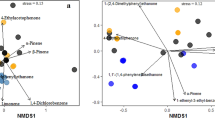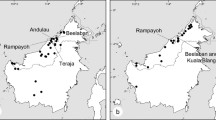Abstract
Information on intra-specific variation in pollinator-attracting floral traits provides clues to selective pressures imposed by pollinators. However, these traits also reflect constraints related to floral phenology or morphology. The specific weevil pollinator Derelomus chamaeropsis of the dioecious Mediterranean dwarf palm Chamaerops humilis is attracted by volatile compounds that leaves, and not flowers, release during anthesis. Production of these olfactory cues is thus probably not constrained by any other floral function. This provides the opportunity to study variation of a “floral” trait that is not produced by a floral organ. We studied volatile compounds emitted by leaves of 12 individual C. humilis over the whole flowering season. The quantity of volatile compounds emitted by leaves reached a maximum when plants required pollinator visits. The relationship between odour emission and floral phenology was slightly different between male and female plants, probably reflecting differences in the exact time at which females and males benefit from pollinator visitation. Male plants produced higher quantities of volatile compounds than females. Odour composition was highly variable among individuals but did not differ between male and female plants. In this system, female C. humilis are pollinated by deceit and pollinators should be selected to avoid visiting them. The absence of sexual difference in blend composition may thus prevent pollinators from discriminating between male and female plants.



Similar content being viewed by others
References
Adams RP (1995) Identification of essential oil components by gas chromatography/mass spectroscopy. Allured, Carol Stream, Ill.
Ågren J, Elmqvist T, Tunlid A (1986) Pollination by deceit, floral sex ratios and seed set in dioecious Rubus chamaemorus L. Oecologia 70:332–338
Anstett M-C (1999) An experimental study of the interaction between the dwarf palm (Chamaerops humilis) and its floral visitor Derelomus chamaeropsis throughout the life cycle of the weevil. Acta Oecol 20:551–558
Armstrong JE (1997) Pollination by deceit in nutmeg (Myristica insipida); floral displays and beetle activity at male and female trees. Am J Bot 84:1266–1274
Ayasse M, Schiestl FP, Paulus HF, Lofstedt C, Hansson B, Ibarra F, Francke W (2000) Evolution of reproductive strategies in the sexually deceptive orchid Ophrys sphegodes: how does flower-specific variation of odor signals influence reproductive success? Evolution 54:1998–2006
Bawa KS (1980) Mimicry of male by female flowers and intrasexual competition for pollinators in Jacaratia dolichaula (D. Smith) Woodson (Caricaceae). Evolution 34:467–474
Bergström J, Bergström G (1989) Floral scents of Bartsia alpina (Scrophulariaceae): chemical composition and variation between individual plants. Nord J Bot 9:363–365
Bohlman J, Meyer-Gauen G, Croteau R (1998) Plant terpenoid synthases: molecular biology and phylogenetic analysis. Proc Natl Acad Sci USA 95:4126–4133
Charnov EL (1979) Simultaneous hermaphroditism and sexual selection. Proc Natl Acad Sci USA 76:2480–2484
Dafni A (1984) Mimicry and deception in pollination. Annu Rev Ecol Syst 15:259–278
Delph LF, Galloway LF, Stanton ML (1996) Sexual dimorphism in flower size. Am Nat 148:299–320
Dobson HEM (1994) Floral volatiles in insect biology. In: Bernays EA (ed) Insect-plant interactions. CRC, Boca Raton, Fla., pp 47–81
Dobson HEM, Groth I, Bergström G (1996) Pollen advertisement: chemical contrasts between whole-flower and pollen odors. Am J Bot 83:877–885
Dufaÿ M, Anstett M-C, Hossaert-McKey M (2003) When leaves act like flowers: how dwarf palms attract their pollinators. Ecol Lett 6:28–34
Dufaÿ M, Anstett M-C (2004) Cheating is not always punished: killer female plants and pollination by deceit in the dwarf palm Chamaerops humilis. J Evol Biol (in press)
Dukas R (1987) Foraging behavior of three bee species in a natural mimicry system: female flowers which mimic male flowers in Ecballium elaterium (Cucurbitaceae). Oecologia 74:256–263
Eckart VM (1999) Sexual dimorphism in flowers and inflorescences. In: Geber MA, Dawson TE, Delph LF (eds) Gender and sexual dimorphism in flowering plants. Springer, Berlin Heidelberg New York, pp 123–148
Eckert CG, Manicacci D, Barrett SCH (1996) Frequency-dependent selection on morph ratios in tristylous Lythrum salicaria (Lythraceae). Heredity 77:581–588
Faegri K, Van der Pijl L (1979) The principles of pollination ecology. Pergamon, Oxford
Fry JD, Rausher MD (1997) Selection on a floral color polymorphism in the tall morning glory (Ipomoea purpurea): transmission success of the alleles through pollen. Evolution 51:66–78
Galen C (1999) Why do flowers vary ? Bioscience 49:631–640
Galen C, Kevan PG (1980) Scent and color, floral polymorphisms and pollination biology in Polemonium viscosum Nutt. Am Midl Nat 104:281–289
Gigord LDB, Macnair MR, Smithson A (2001) Negative frequency-dependent selection maintains a dramatic flower color polymorphism in the rewardless orchid Dactylorhiza sambucina (L.) Soò. Proc Natl Acad Sci USA 98:6253–6255
Gouinguené S, Degen T, Turlings TCJ (2001) Variability in herbivore-induced odour emissions among maize cultivars and their wild ancestors (teosinte). Chemoecology 11:9-16
Grison-Pigé L, Bessière JM, Turlings TCJ, Kjellberg F, Roy J, Hossaert-McKey M (2001) Limited intersex mimicry of floral odour in Ficus carica. Funct Ecol 15:551–558
Groth I, Bergström G, Pellmyr O (1987) Floral fragances in Cimicifuga: chemical polymorphism and incipient speciation in Cimicifuga simplex. Biochem Syst Ecol 15:441–444
Heath RR, Manukian A (1994) An automated system for use in collecting volatile chemicals released from plants. J Chem Ecol 20:593–607
Johnson SD, Steiner KE (2000) Generalization versus specialization in plant pollination systems. Trends Ecol Evol 15:140–143
Johnson SG, Delph LF, Elderkin CL (1995) The effect of petal-size manipulation on pollen removal, seed set, and insect-visitor in Campanula americana. Oecologia 102:174–179
Knudsen JT (2002) Variation in floral scent composition within and between populations of Geonoma macrostachys (Arecaceae) in the western Amazon. Am J Bot 89:1772–1778
Knudsen JT, Tollsten L (1995) Floral scent in bat-pollinated plants: a case of convergent evolution. Bot J Linn Soc 119:45–57
Levin RA, McDade LA, Raguso RA (2003) The systematic utility of vegetative fragrances in two genera of Nyctaginaceae. Syst Biol 52:334–351
Menzel R, Shmida A (1993) The ecology of flower coulours and the natural colour vision of insect pollinators: the Israeli flora as a study case. Biol Rev 68:81–120
Møller AP, Sorci G (1998) Insect preference for symmetrical artificial flowers. Oecologia 114:37–42
Peakall R, Handel SN (1993) Pollinators discriminate among floral heights of a sexually deceptive orchid: implications for selection. Evolution 47:1681–1687
Pellmyr O, Thien LB (1986) Insect reproduction and floral fragrances: keys to the evolution of the angiosperms? Taxon 35:76–85
Robertson JL, Wyatt R (1990) Evidence for pollination ecotypes in the yellow-fringed orchid, Platanthera ciliaris. Evolution 44:121–133
SAS (1999) Release 8.02. SAS Institute, Cary, N.C.
Schemske DW, Bradshaw HD (1999) Pollinator preference and the evolution of floral traits in monkeyflowers (Mimulus). Proc Natl Acad Sci USA 96:11910–11915
Schiestl FP, Ayasse M (2001) Post-pollination emission of a repellent compound in a sexually deceptive orchid: a new mechanism for maximising reproductive success? Oecologia 126:531–534
Schiestl FP, Ayasse M, Paulus HF, Erdmann D, Francke W (1997) Variation of floral scent emission and postpollination changes in individual flowers of Ophrys sphegodes subsp. sphegodes. J Chem Ecol 23:2881–2895
Shaver TN, Lingren PD, Marshall HF (1997) Nighttime variation in volatile content of flowers of the night blooming plant Gaura drummondii. J Chem Ecol 23:2673–2682
Subramaniam B, Rausher MD (2000) Balancing selection on a floral polymorphism. Evolution 54:691–695
Williams CF, Kuchenreuther MA, Drew A (2000) Floral dimorphism, pollination, and self-fertilization in gynodioecious Geranium richardsonii (Geraniaceae). Am J Bot 87:661–669
Willson MF (1979) Sexual selection in plants. Am Nat 113:777–790
Young HJ, Stanton ML (1990) Influences of floral variation on pollen removal and seed production in wild radish. Ecology 71:536–547
Acknowledgements
The authors are grateful to Jean-Marie Bessière, who identified the chemical compounds. We thank Eric Crantor and Nasser Rouibi for their invaluable assistance in odour collections, and Michelle Beltran for help in the gas chromatography analysis. We thank Nadir Alvarez, Doyle McKey, Finn Kjellberg, John Thompson, and three anonymous reviewers for their helpful reading of various versions of the manuscript.
Author information
Authors and Affiliations
Corresponding author
Additional information
An erratum to this article can be found at http://dx.doi.org/10.1007/s00442-004-1606-3
Rights and permissions
About this article
Cite this article
Dufaÿ, M., Hossaert-McKey, M. & Anstett, MC. Temporal and sexual variation of leaf-produced pollinator-attracting odours in the dwarf palm. Oecologia 139, 392–398 (2004). https://doi.org/10.1007/s00442-004-1538-y
Received:
Accepted:
Published:
Issue Date:
DOI: https://doi.org/10.1007/s00442-004-1538-y




